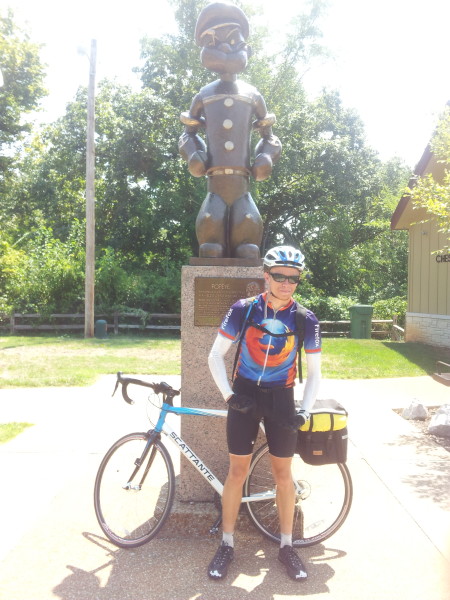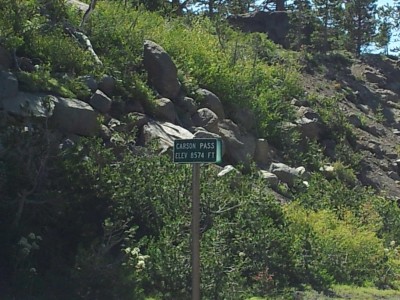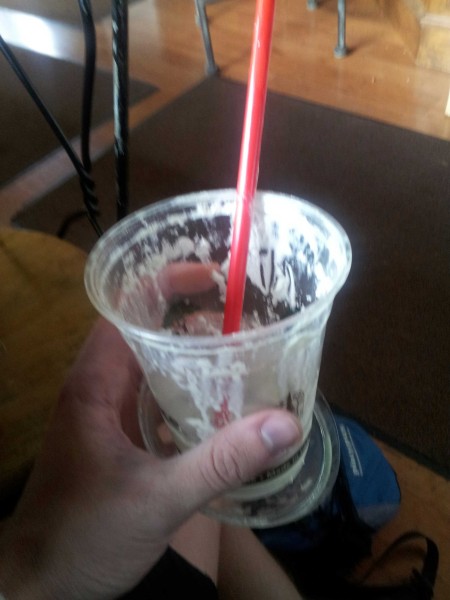This is part nine of a series of posts discussing various aspects of a bike trip I did across the United States in 2012. Part one discussed the start of the trip and choosing a route. Part two discussed my daily routine and nightly shelter. Part three discussed general mileage, elevation encountered, and state-by-state scenery. Part four discussed mileage extremes and water. Part five discussed food. Part six discussed elevation extremes, particularly crossing the Continental Divide at Monarch Pass. Part seven discussed how I used down time and how I kept electronics charged. Part eight discussed mechanical problems and other surprises. This post discusses health issues I had along the way.
A marathon
It’s one thing to bike a hundred miles in a day, once. It’s another to do it several days in a row, as I’ve done several times on the DALMAC ride in Michigan (80-100mi/day for four or five days, on the routes I’ve taken). In a certain sense, it really isn’t that different to bike a hundred miles a day (average) for over a month. It is a bit different, however, when that month includes no true, complete rest days. Without rest days, you give your body almost no time to heal before it’s back on again for another day of beating. 🙂
I could feel, as I traveled, that I was always slightly on the edge of exhaustion. I didn’t get a cold, but I could tell I was always on the very edge of one: slightly out of breath all the time, with a slight cough that never really went away, slightly weary every morning as I woke up to prepare for yet another long day of riding. I’m actually somewhat surprised I didn’t get one, from the constant strain I was putting on my immune system.
Beyond simple exhaustion, my pace and timing forced certain health sacrifices on me, that being able to truly rest might have healed quicker.
Pulled muscles
At some point on the first day, I pedaled slightly too aggressively, quickly, or eagerly with my right leg, and I slightly pulled a back lower-leg (ankle?) muscle. This didn’t prevent me from cycling, but it did make it slightly painful to push hard while pedaling with that leg: I cycled for about a week with my right toes pointed downward further than I might ordinarily do, so that I wouldn’t stress it. Interestingly, as soon as it healed, I experienced the same slight injury to my left leg, and it too was slightly out of sorts for a week. Neither injury materially interfered with cycling, and both were only barely noticeable while walking. But a day off might have healed these injuries, rather than having to live with them for a week each of cycling, if I’d been able to take one. (Or it might have taken several days regardless, for all I know.)
Left knee pain
The other pain I experienced, that I’m still at somewhat of a loss to explain, was in the muscle just above my knee, on the front inside. It first arose on the third day as I climbed from Folsom Lake into the Sierras, subsided overnight, then returned again the next day up and over Carson Pass. The pain was much of the reason my third day was comparatively short and slow. The other side of the Sierras, I stopped at a bike shop to ask if they had any ideas what might be causing the pain. (I, er, carefully didn’t mention the bike was only four days old, figuring if there was a problem, it should be visible and observable regardless. Not that I was afraid of looking stupid or anything, of course.) Their only thought was my left cleat was misaligned, but I hadn’t touched that cleat in over a year, so it seemed pretty unlikely. But the pain appeared to correlate with ascending, and Nevada promised to be flatter, so they suggested continuing on and seeing what happened. And indeed, the pain disappeared — all the way til Virginia. Then I felt it almost returning, at lesser intensity, by the latter phases of each day.
My initial thought was that the pain was some early-trip lack of strength which subsided after some toughening up. But that wouldn’t explain its reappearance at the end of the trip. (I dealt with it at end by trying to bike slightly easier and by wearing my slightly-compressing leg warmers. A doctor would of course have recommended rest, but that Wasn’t Going To Happen, so I did the best I could in its absence.) Even now I’m still not sure what might have caused it. Perhaps, even given a year at that position, the cleat still needed adjustment when subjected to particularly harsh climbing? *shrug*
Next time, the logistics of getting home.



